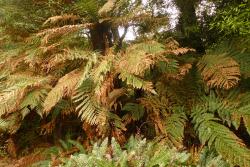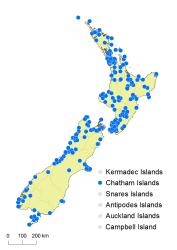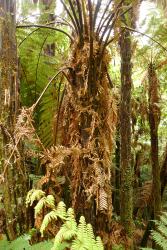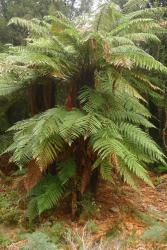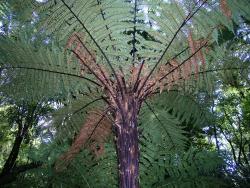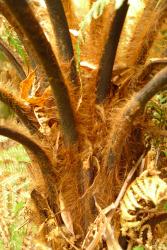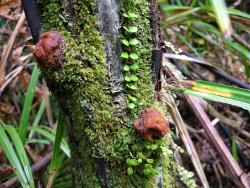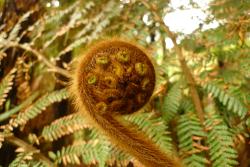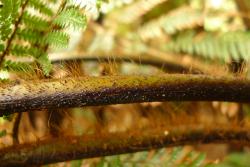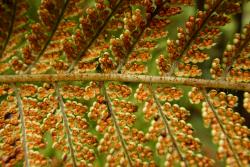- Taxon
- Gallery
- ≡ Trichomanes squarrosum G.Forst., Fl. Ins. Austr. 86 (1786)
- ≡ Balantium squarrosum (G.Forst.) Kunze, Index Filic. 11 (1850)
- = Dicksonia gracilis Colenso, Trans. & Proc. New Zealand Inst. 15: 306 (1883)
- ≡ Dicksonia squarrosa var. gracilis (Colenso) C.Chr., Index Filic. 221 (1905)
Rhizomes erect, forming a woody trunk up to 7 m tall, 90–200 mm diam., covered in dark brown hairs and persistent black stipe bases; forming aerial buds that sometimes grow out to form multiple trunks; bearing underground stolons and often forming extensive groves. Fronds 1250–2400 mm long, falling when old; dead fronds orange-brown. Stipes 210–660 mm long, dark purple-brown, rough, often bearing fine golden-brown hairs at the junction with the trunk, densely covered in red-brown or yellow-brown multicellular hairs up to 45 mm long proximally, and red-brown hairs to 10 mm long distally. Laminae 2-pinnate-pinnatifid (sterile) to 3-pinnate-pinnatifid (fertile), elliptic or obovate, 1000–1400 mm long, 400–600 mm wide, dark green on adaxial surfaces, paler green on abaxial surfaces, coriaceous, very harsh, densely hairy on abaxial surfaces of rachis, pinna midribs and costae; hairs rigid, multicellular, red- or purple-brown, more or less straight, up to 5 mm long, uniformly distributed, with finer yellow-brown hairs near costa junctions; rachis red-brown or purple-brown. Primary pinnae in 35–45 pairs, narrowly ovate or narrowly triangular; the longest at or above the middle, 200–420 mm long, 55–145 mm wide, stalked; the basal pair 100–250 mm long. Secondary pinnae narrowly triangular, the longest 30–75 mm long, 8–20 mm wide, stalked. Longest tertiary pinnae 4–12 mm long, 2–3 mm wide, decurrent to form a narrow wing along the costa of the secondary pinna, divided less than halfway to midrib; ultimate segments sharply angled. Sori terminating veins at margins of lamina, ovate, c. 1 mm long, slightly elongated along the lamina margin.
Dicksonia squarrosa is readily recognised by the black stipe bases on the trunk, the presence of aerial buds, the very harsh fronds, and the characteristically orange-brown dead fronds. There are red-brown, rigid, multicellular, uniformly distributed hairs on the abaxial surface of the costae. If the crown or upper part of the trunk is damaged, the aerial buds may grow out to form a multi-headed tree fern. The stoloniferous habit means that the species often grows in groves, with a mixture of young and old trunks.
North Island: Northland, Auckland, Volcanic Plateau, Gisborne, Taranaki, Southern North Island.
South Island: Western Nelson, Sounds–Nelson, Marlborough, Westland, Canterbury, Otago, Fiordland, Southland.
Three Kings Islands, Chatham Islands, Stewart Island.
Altitudinal range: 0–900 m.
Dicksonia squarrosa occurs throughout the North Island in coastal to montane forest. It grows from near sea-level to 860 m in the Kaweka and Ruahine ranges. In the South Island it is largely confined to coastal and lowland sites, but reaches 500 m near Haast, and 900 m at Jordan Stream, Marlborough.
Occurs under mānuka, tawa, pōhutukawa, podocarp, beech and broadleaved forest, or in second-growth forest, open scrub, on forest margins, and occasionally in dune hollows or open pasture. It often grows along creek banks, or on poorly-drained or swampy soil. It frequently forms extensive groves; the dense shade, combined with the dead fronds that cover the ground, tends to discourage germination of any other species underneath the grove.
There are two syntype specimens of D. gracilis in WELT but Allan (1961) effectively identified the lectotype by describing uniquely the material on the sheet ("… a small part of a rachis with 6 pinnae …").



